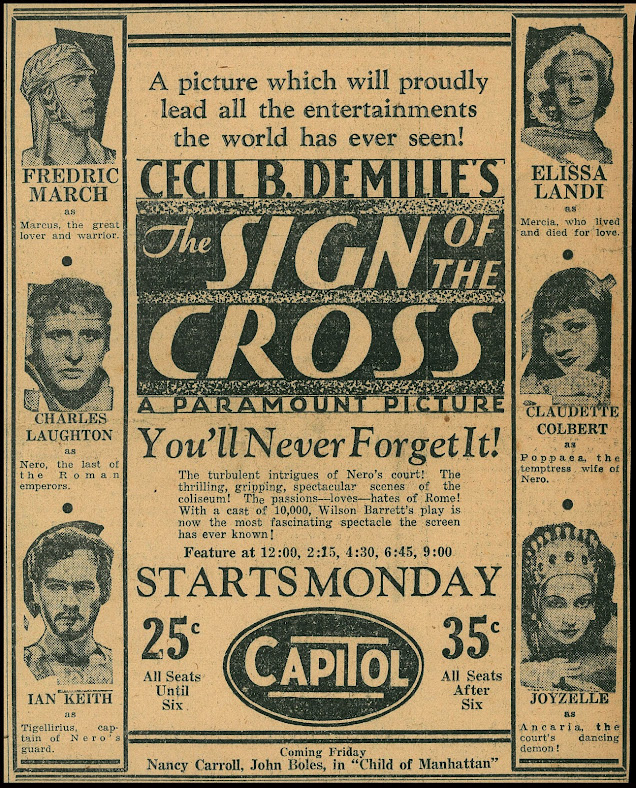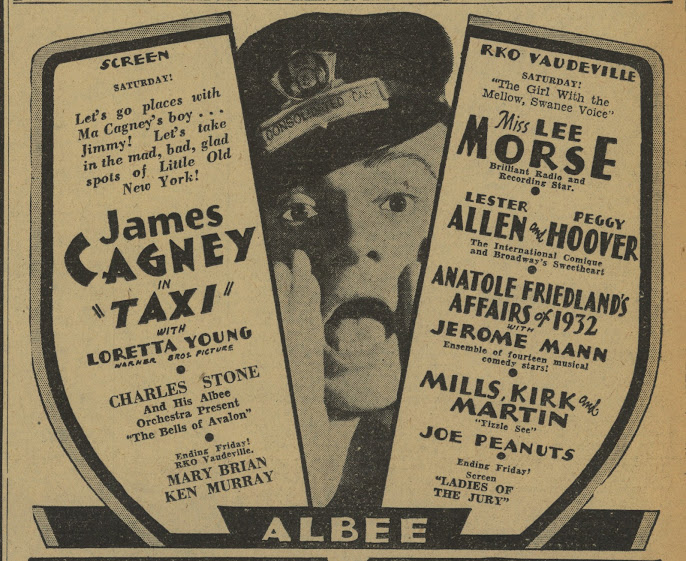The Precodes Are Loose #1
Thirties Trek Back and Let Pre-Codes Commence
After chaotic fashion of Greenbriar’s ongoing Film Noir series, we engage now the Precode era, never minding alphabetical policy that drove noir into shoals (a year and a half in and still with the B’s). Precode selections will be random, titles not addressed before at GPS. Precode is less rich a vein than noir mostly because it had a distinct beginning and finite end, in upon wings of sound, out with vigorous enforcement of the Code as of summer 1934. Noir defines more fluidly; we customize it to suit ourselves, thus Ford Fairlane included. Precode and noir ran a trendy race over decades since being identified, noir in the seventies, precode later when TNT, AMC, and finally TCM made many available to celebrate. Appears now that noir as tortoise has overtaken hare that is precode. Frisky though they were and remain, precodes don’t age as well, their language increasingly a foreign one, slanguage precious few remain to translate. Noir soothes for more modern backgrounds and attitude, less damnably old at least. Reality of early 30’s audience gone in toto cools ardor for stuff they were first to see, precode not the “thing” it was. So much too is inaccessible. Think owner Disney will loose bounty that is the Fox Film Corporation and precodes we long to look at? Not likely. Precode it seems has become more the stuff of connoisseurs, filmic equivalent of Latin or Greek cipher. There still is capacity to shock, often for reasons that would not have been apparent when precodes were new. Context counts and then-reaction that was trade talk and exhibitor activism will play into this and future columns on the topic, beginning with grenade toss that was Sign of the Cross in 1932, also theme by chance today that is Loretta Young, recent focus on TCM, thus view of three with her as follow:
LOOSE ANKLES (1930) --- Nearly ankled this for antiquity almost oppressive, surest test of so-called film lovers their patience for 1929-30 releases. Loose Ankles is comedy not funny, threat to be a musical except no one sings, and a cast finding feet at talk. Copyright date in credits reads 1929, so learn-on-the-talking-job prevails. Story in nutshell: Heiress seeks scandal so she can lose a large inheritance under terms of a will. She already has more money than she could spend, relatable (not) to crowds watching in 1930 who knew hard times were a-coming. Fascinating how good ideas prior to October 1929 became bad ideas so soon after. Loose Ankles would have been hooted out of venues had any used it by 31-32, not a likelihood as product was spent like bathroom tissue and flushed as fast. Imagine Loretta Young or Douglas Fairbanks Jr. coming upon Loose Ankles on late 50’s TV. Must have seemed to them like strangers doing foolish things on that blurry tube. We all have aspects of past that embarrass now, disco era conduct or some such, but to be besieged nightly by stuff so mortifying to moderns … how did Doug and Gretchen face friends the next day? Fairbanks talked about this some in his books, and Bette Davis never lived down her salad days, like Parachute Jumper for instance, with Doug. Just occurs to me --- Salad Days was what latter called his first memoir, apt to be sure. Screen veterans needed a late show support group. I’d take the gas pipe over watching Loose Ankles again but don’t regret the TCM sit. Proceedings were based on a play, so … did the play amuse? It had 168 performances in 1926-27, good by Broadway standard. Loretta Young was sixteen when she did Loose Ankles, by then having seen it all and then some.
THEY CALL IT SIN (1932) --- Country-bashing cousin to Hot Saturday, They Call It Sin gets in rural licks via city slick David Manners hot/bothered over Kansas blossom (among weeds) Loretta Young, who plays the church organ when she should pursue higher purpose that is Broadway, says Manners. Her parents revealed not to be her parents (won’t detail that) are dedicated repressors, praying at table, all such bunkum as defined by denizens of day-of-locust Hollywood. Again I get fully why heartlanders turned solidly against sneering biz, enough insults being enough by 1933-34. They Call It Sin turns timid to extent of Young-Manners not indulging youth’s passion, her assuring Mom-Dad not Mom-Dad she’s “done nothing to be ashamed of,” shorthand that no consummation took place, surprising (if disappointing) device prior to strict apply of the Code. I wanted them to have had a tumble, especially in light of silly sacrifice Manners makes in a third act, followed by Young’s outlandish attempt at same, then everybody having selfless go, including Louis Calhern, a satisfying heavy up to then. There is fun of him plus George Brent, Una Merkel, more. Talk about gagging at noble intent, there is soon-to-be-stale exchange between proposed adulterers, to wit “We can’t build our happiness upon the unhappiness of others,” which I bet no would-be adulterers in real life ever said, or ever will. Lesson of They Call It Sin: Not all pre-code dealt raw. Had Warners been warned? Best thing about frisky film from that period is likelihood people will comport like flawed rest of us, and They Call It Sin does not quite do that.
CROSS COUNTRY CUTS FOR CROSS --- Early thirties as torrid stream of precode pleases in principle, but facts belie belief that ribald rousers never had things so good. Example among many: Sign of the Cross as directed by C.B. DeMille in 1932, a five-alarm biblical fire stanched till a complete 35mm print was found in the director’s basement vault. Paramount had reissued Sign of the Cross in 1944, shorn of sex and violence rife in 1932 prints, but were even those from ’32 intact? Pete Harrison of free-thinking Harrison’s Reports saw, and was incensed, by Sign of the Cross when roadshown in New York, where “some women fainted; others put their hands across their eyes to shut out the dreadful views.” Screen story revolved around Christian persecution by Rome, “gladiators … fighting to death with pitchforks; amazons piercing dwarfs with their swords; a tiger feeding on human flesh; an elephant stepping on the head of a human being and crushing him to death, and other horrible sights.” Harrison reported some of footage removed after opening day, “and a suggestion was made to Mr. DeMille to cut out more of the scenes of cruelty, but he did not accept it.” Noise was getting to Paramount East Coast brass. Would the company lose money for too-explicit distillation of the Good Book? Sign of the Cross went to Radio City Music Hall where manager Harold Franklin hauled the print to his on-site editing room and took out all offending portions, “leaving only enough … to suggest the cruelty of the Romans.” A rape of art? Not the way Franklin saw it, him merely protecting his theatre’s investment. Who needed customer complaints and women fainting? Hard to know what countrywide audiences later saw once Sign of the Cross got into general release, but I’m guessing it kept little faith with DeMille’s vision. What he preserved in that basement was undoubtedly complete --- would he have kept the print otherwise? We are shocked by films summarily cut today, but wait, what of The French Connection? Sign of the Cross happily survives as DeMille intended, Kino’s Blu-Ray having been sourced from his keepsake. Call this happy accident of fate, then mourn anew those precodes gelded and never put right, unlikely to be ours again as intended by makers.
TAXI (1931) --- Seems taxi wars were real in New York, cabs hijacked, fares cut and then tires, a carnival with checkered bumper cars smashing into each other, drivers dragged out and sometimes killed. Hard blaming short fuse that is Cagney’s “Matt Nolan” whom Strand audiences ID’ed intensely with, smacking sweethearts round and resorting regular to fists and gun. His was simplest survival mechanism as 1931-32 public saw it, but which public? Certainly not rural ones, these understandably shocked by collapse of civilization evidently the lot of over-represented Gotham in movies. How dependent was Cagney stardom upon urban trade? Much of early thirties Warner lost money, bloom off rose that was talkies-as-novelty. Taxi had a $250K negative cost and earned $458K in domestic rentals, $115K foreign. Final profit was $80K, better than it sounds because this was Depression money with something preferred always to nothing. Take away the Strand and NY boroughs cash and I wonder if Taxi, or Cagney, could have lasted. He needed out of crime and go-getter topics to keep a following, the star hep to risk of sameness. Meaningful was Footlight Parade being his biggest to 1933 point, service yarns after to confirm Cagney as more mainstream, not just a hoodlum with humor. Taxi posited the coming star as still grapefruit wielding threat, less funny than scary when he bats Loretta Young about. She takes it, doesn’t like it, but still takes it. Question was whether a wide public would take it. Did New Yawkers cheer such conduct? Taxi went toward explaining why outliers dreaded the place and would largely avoid it. Ninety years later, have things changed, except maybe for the worse?










5 Comments:
I have THE SIGN OF THE CROSS in the Universal Cecil B. DeMille Collection, which also includes CLEOPATRA, FOUR FRIGHTENED PEOPLE, THE CRUSADES, and UNION PACIFIC. It's interesting to see the Pre and Post-Code impact on his films. That being said, TSOTC is one wild ride. On a side note, when it was reissued around 1943, there was a new prologue added, showing a WWII crew of pilots flying over Italy, talking about the days of Nero, which leads into the edited version. Anyway, I'd always remembered Harry Carey as the veteran pilot. I was probably confusing this with his role in AIR FORCE, as someone kindly pointed out to me that it was actually the fine character actor John Ridgely!
On a side nite, I think Loretta Young was just about the loveliest actress, ever. Like Cyd Charisse, she seemed to reach fifty and never aged after that.
Odd that people feel the need to impose rules on what their fairy tales are permitted to relate.
Odd too that censorship never aims at incompetent editing or writing or acting or production quality in general, but only at the "content" of productions.
Also odd that going to the movies should regularize and normalize a "need" to produce official identification papers showing one's age when people are young, a requirement now expanded to many other things in life - like voting.
For some reason recalling DeMille's "Four Frightened People", about four passengers escaping a plague ship and having harrowing adventures in the jungle. It's dark and grim much of the way, touching on precode. Then physical peril is safely past and the movie rolls on, the protagonists effectively safe and comfortable with civilized romantic tension promoted to foreground.
SPOILER:
During the grimmer part of the film one of the four, a spinster, is taken away by hostile natives to a presumed ghastly fate. Much later, we have a comic scene in a native village. The womenfolk, organized by the spinster, are demanding equal rights. The distressed chief orders her sent back to her own people, where she becomes a celebrity. Was this plot turn always in the script?
Having grown up when movies of this kind were never shown on TV, I was thrilled when TCM arrived. Then I started watching movies from 1929, and realized how unwatchable many of them are. Take away "The Cocoanuts", and there's not many left worth the sit. Another thing that TCM taught me was that movies from the years immediately after the enforcement of the Code are pretty bland stuff. It seems like things didn't start revving up until 1939, and then exploded in the '40s and '50s.
James Cagney's pre-codes are terrific; it's too bad "Public Enemy" and "Footlight Parade" are the only ones that people seem to know about. And as for Loretta Young -- remarkably beautiful. No wonder why Spencer Tracy fell hard for her when making a movie together. She kind of reminds me of Angelina Jolie, only less exotic and more wholesome-looking.
I saw "Taxi" in my teens on a nearby TV station that was the first in the area to broadcast 24 hours and in the late nights they ran old Warner films (and cartoons). My ears perked up when Cagney said "You dirty double-crossing rat!" I'd read his autobiography and in a chapter where he dispelled myths about himself, he wrote "by the way, I never said 'you dirty rat!'"
Well, he was sort of right.
Post a Comment
<< Home